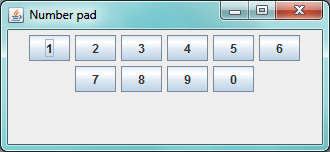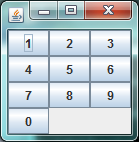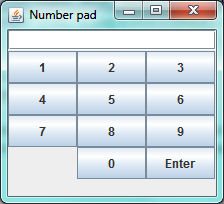1: Our simple example
- A number pad (as for a calculator or phone)
- Draw a quick/basic design sketch of out what you're going for:

Implementations:
| Array-based (directly/by index) | Array-based (iterator) | Linked (directly/by index) | Linked (iterator) | |
|---|---|---|---|---|
| add (append) | O(1)* | O(1)* | O(1) (w/ tail ptr) | O(1) |
| add (insert) | O(n) | O(n) | O(n) | O(1) |
| get | O(1) | O(1) | O(n) | O(1) |
| remove | O(n) | O(n) | O(n) | O(1) |
Interfaces
Implementations
Essentials:

JPanel top = new JPanel();
//create buttons
JButton[] buttons = new JButton[10];
for (int i = 0; i < buttons.length; i++) {
buttons[i] = new JButton("" + i);
if (i > 0) {
top.add(buttons[i]); //add each button to the top JPanel
}
}
top.add(buttons[0]);
//then put top into a JFrame (window)...


JPanel top = new JPanel();
top.setLayout(new GridLayout(4, 3)); //row, col
//create buttons
JButton[] buttons = new JButton[10];
for (int i = 0; i < buttons.length; i++) {
buttons[i] = new JButton("" + i);
if (i > 0) {
top.add(buttons[i]); //add each button to the top JPanel
}
}
top.add(buttons[0]);
//then put top into a JFrame...


public class NumberPad {
//components we may need to refer to later
private JPanel top;
private JButton[] buttons;
private JButton enter;
private JTextField input;
private JLabel output;
/** Builds the top-level JPanel of the NumberPad GUI. */
public NumberPad() {
//top level
this.top = new JPanel();
top.setLayout(new BorderLayout());
//first row: input field
this.input = new JTextField();
top.add(input, BorderLayout.PAGE_START); //put in top
//create buttons
buttons = new JButton[10];
for (int i = 0; i < buttons.length; i++) {
buttons[i] = new JButton("" + i);
}
//center row: a grid of buttons 1-9, and then 2 more buttons underneath
JPanel center = new JPanel();
center.setLayout(new GridLayout(4, 3));
for (int i = 1; i <= 9; i++) {
center.add(buttons[i]);
}
center.add(new Label("")); //spacer
center.add(buttons[0]);
this.enter = new JButton("Enter");
center.add(this.enter);
this.top.add(center, BorderLayout.CENTER);
//bottom row: an non-editable output/status field
this.output = new JLabel(" "); //a space so it has some height
this.top.add(this.output, BorderLayout.PAGE_END);
}
public static void main(String[] args) {
JFrame window = new JFrame("Number pad");
window.setDefaultCloseOperation(JFrame.EXIT_ON_CLOSE);
NumberPad pad = new NumberPad();
window.setContentPane(pad.top);
window.pack();
window.setVisible(true);
}

import javax.swing.*; import java.awt.*; import java.awt.event.*; public class NumberPad implements ActionListener { //components we may need to refer to later private JPanel top; private JButton[] buttons; private JButton enter; private JTextField input; private JLabel output; /** Builds the top-level JPanel of the NumberPad GUI. */ public NumberPad() { //top level this.top = new JPanel(); top.setLayout(new BorderLayout()); //first row: input field this.input = new JTextField(); this.input.setHorizontalAlignment(JTextField.RIGHT); this.input.addActionListener(this); top.add(input, BorderLayout.PAGE_START); //put in top //create buttons buttons = new JButton[10]; for (int i = 0; i < buttons.length; i++) { buttons[i] = new JButton("" + i); buttons[i].addActionListener(this); } //center row: a grid of buttons 1-9, and then 2 more buttons underneath JPanel center = new JPanel(); center.setLayout(new GridLayout(4, 3)); for (int i = 1; i <= 9; i++) { center.add(buttons[i]); } center.add(new Label("")); //spacer center.add(buttons[0]); this.enter = new JButton("Enter"); this.enter.addActionListener(this); center.add(this.enter); this.top.add(center, BorderLayout.CENTER); //bottom row: an non-editable output/status field this.output = new JLabel(" "); //a space so it has some height this.top.add(this.output, BorderLayout.PAGE_END); } public void actionPerformed(ActionEvent ae) { if (ae.getSource() == this.enter || ae.getSource() == this.input) { //Enter button clicked or enter pressed in input field this.output.setText("Entered: " + this.input.getText()); this.input.setText(""); }else if (ae.getSource() instanceof JButton) { JButton pressed = (JButton) ae.getSource(); //one of the buttons must have been clicked: add that value to input this.input.setText(this.input.getText() + pressed.getText()); } } public static void main(String[] args) { JFrame window = new JFrame("Number pad"); window.setDefaultCloseOperation(JFrame.EXIT_ON_CLOSE); NumberPad pad = new NumberPad(); window.setContentPane(pad.top); window.pack(); window.setVisible(true); } }